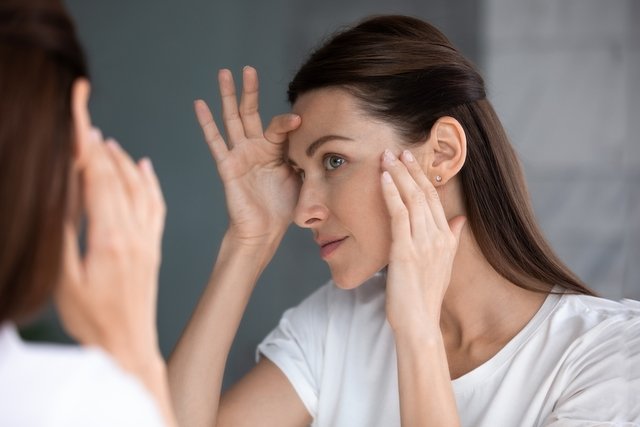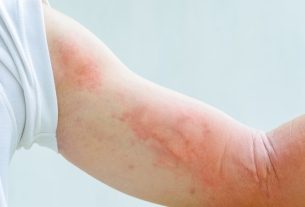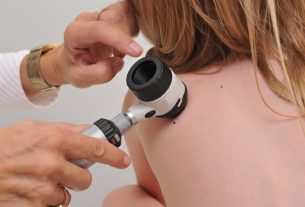The white spot on the face can appear due to normal changes in skin aging or frequent exposure to the sun, without it being considered a problem. However, in some cases, these spots can also indicate diseases such as vitiligo and pityriasis alba or be caused by contact with chemicals.
Generally, white spots result from changes in the function of melanocytes, cells responsible for producing melanin and giving color to the skin, which can be destroyed or start to produce less melanin in the case of diseases, exposure to toxic products or aging, for example. .
Therefore, in the presence of one or more white spots on the face, it is recommended to consult a dermatologist for an evaluation so that the cause can be identified and the most appropriate treatment can be initiated, if necessary.
Main causes
The main causes of white spots on the face are:
1. Aging
A decrease in the number of melanocytes and melanin production is common due to aging, resulting in the appearance of white spots on the face, which may initially appear on the face and later appear on other parts of the body, especially the arms.
What to do: In this case, no treatment is necessary, as these are changes considered normal in aging.
However, it is interesting to consult a dermatologist to have the spots evaluated. Although treatment is not necessary, the use of sunscreen is generally recommended and corticosteroid ointments may be recommended, reducing blemishes and improving the appearance of the skin in some cases.
2. Frequent exposure to the sun
Frequent exposure to the sun may also be related to the appearance of white spots on the face over time, although they generally affect mainly the arms. These spots are believed to be caused by mild inflammation that sunlight can cause to the skin.
What to do: White spots on the face and arms caused by frequent exposure to the sun generally do not require treatment, although they tend to increase in number if exposure continues frequently. However, using sunscreen can be useful to prevent the stain from becoming even more visible on the skin.
In addition, a dermatologist can be consulted to recommend treatments that can improve the appearance of the skin, such as the application of ointments with corticosteroids and retinoids. See what corticosteroid ointments are for and when to use them.
3. Chemicals
Exposure to some chemicals such as phenols or hydroquinone, in professions related to rubber or leather production, for example, and some acids, such as those used in chemical peeling, can cause white spots on the face or other parts of the body, depending on the region. exposed.
This occurs due to the destruction of melanocytes in the skin or impairment of melanin production caused by these products.
What to do: It is important to avoid direct contact with chemicals by using appropriate protective equipment. Furthermore, inappropriate use without medical advice of acids and hydroquinone should be avoided. Did you know what hydroquinone is and what it is for.
If you suspect white spots caused by chemicals, it is recommended to consult a dermatologist for evaluation and initiation of appropriate treatment, which may involve oral corticosteroids or in the form of ointments.
4. Nutritional deficiencies
Malnutrition and deficiency of nutrients such as iron, copper or vitamin B12 can cause white spots on the face and other parts of the body. Generally, anemia and symptoms such as weakness, tingling throughout the body, brittle nails and hair can also occur in these cases, depending on the type of nutritional deficiency.
What to do: It is important to maintain a balanced and quality diet to avoid a lack of nutrients. See how to have a healthy diet.
However, if a nutritional deficiency is suspected, it is important to consult a general practitioner for an evaluation. If a nutritional deficiency is identified, replacement of nutrients such as iron and vitamin B12 may be indicated, and follow-up with a nutritionist may be recommended.
5. Pitiríase alba
Pityriasis alba is a skin condition that causes a white spot to appear, usually on the face, due to a small inflammation. However, other parts of the body such as the arms and torso can also be affected and the spots tend to be reddish at first. See the symptoms of pityriasis alba and how to confirm the diagnosis.
What to do: The white spot caused by pityriasis alba usually disappears without any specific treatment within a year, and the use of sunscreen is recommended to prevent the spot from becoming more visible on the skin. Furthermore, the use of moisturizing creams can help reduce the peeling of the skin over the blemish.
It is also recommended that a dermatologist be consulted, especially if the spot is red and itchy, as it may be necessary to apply ointments containing corticosteroids to alleviate symptoms and accelerate skin repigmentation.
6. Vitiligo
Vitiligo can cause white patches on the face, usually around the mouth or eyes, or other parts of the body such as the neck, hands and torso, as a result of the absence of melanocytes in the skin. Know how to identify the symptoms of vitiligo.
These spots may change in size over time and are not associated with other symptoms.
What to do: If vitiligo is suspected, it is important to consult a dermatologist for an assessment and initiation of appropriate treatment, which may involve phototherapy and the use of oral corticosteroids, which are capable of preventing the disease from worsening and even recovering skin pigmentation, in some cases. . See more details on treatment options for vitiligo.

Sign up for our newsletter and stay up to date with exclusive news
that can transform your routine!
Warning: Undefined array key "title" in /home/storelat/public_html/wp-content/plugins/link-whisper-premium/templates/frontend/related-posts.php on line 12
Warning: Undefined array key "title_tag" in /home/storelat/public_html/wp-content/plugins/link-whisper-premium/templates/frontend/related-posts.php on line 13




